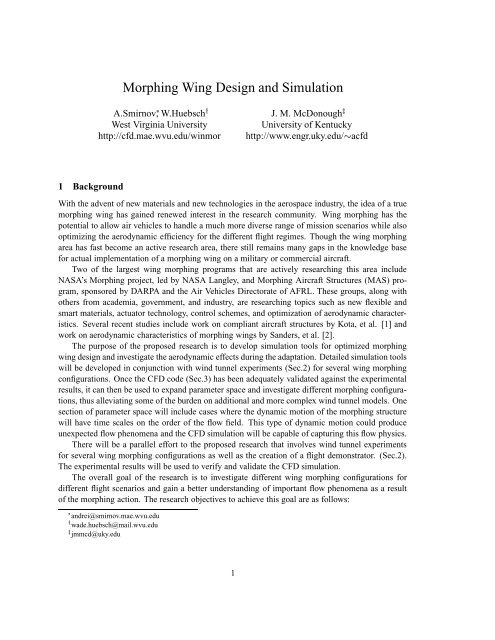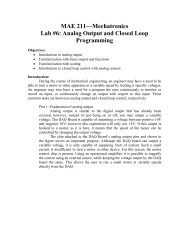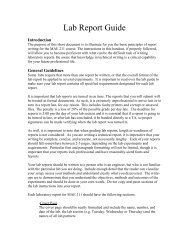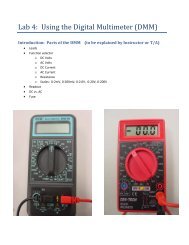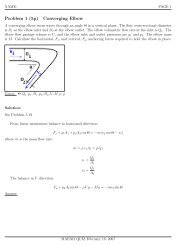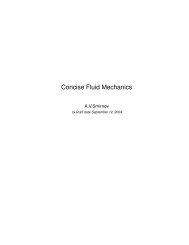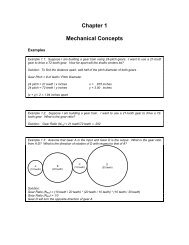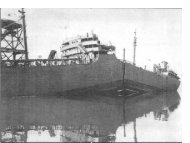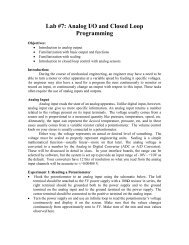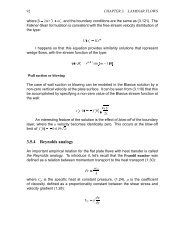Morphing Wing Design and Simulation - Mechanical and Aerospace ...
Morphing Wing Design and Simulation - Mechanical and Aerospace ...
Morphing Wing Design and Simulation - Mechanical and Aerospace ...
You also want an ePaper? Increase the reach of your titles
YUMPU automatically turns print PDFs into web optimized ePapers that Google loves.
¤¥¦<strong>Morphing</strong> <strong>Wing</strong> <strong>Design</strong> <strong>and</strong> <strong>Simulation</strong>A.Smirnov, W.Huebsch ¡West Virginia Universityhttp://cfd.mae.wvu.edu/winmorJ. M. McDonoughUniversity of Kentucky¢acfdhttp://www.engr.uky.edu/£1 BackgroundWith the advent of new materials <strong>and</strong> new technologies in the aerospace industry, the idea of a truemorphing wing has gained renewed interest in the research community. <strong>Wing</strong> morphing has thepotential to allow air vehicles to h<strong>and</strong>le a much more diverse range of mission scenarios while alsooptimizing the aerodynamic efficiency for the different flight regimes. Though the wing morphingarea has fast become an active research area, there still remains many gaps in the knowledge basefor actual implementation of a morphing wing on a military or commercial aircraft.Two of the largest wing morphing programs that are actively researching this area includeNASA’s <strong>Morphing</strong> project, led by NASA Langley, <strong>and</strong> <strong>Morphing</strong> Aircraft Structures (MAS) program,sponsored by DARPA <strong>and</strong> the Air Vehicles Directorate of AFRL. These groups, along withothers from academia, government, <strong>and</strong> industry, are researching topics such as new flexible <strong>and</strong>smart materials, actuator technology, control schemes, <strong>and</strong> optimization of aerodynamic characteristics.Several recent studies include work on compliant aircraft structures by Kota, et al. [1] <strong>and</strong>work on aerodynamic characteristics of morphing wings by S<strong>and</strong>ers, et al. [2].The purpose of the proposed research is to develop simulation tools for optimized morphingwing design <strong>and</strong> investigate the aerodynamic effects during the adaptation. Detailed simulation toolswill be developed in conjunction with wind tunnel experiments (Sec.2) for several wing morphingconfigurations. Once the CFD code (Sec.3) has been adequately validated against the experimentalresults, it can then be used to exp<strong>and</strong> parameter space <strong>and</strong> investigate different morphing configurations,thus alleviating some of the burden on additional <strong>and</strong> more complex wind tunnel models. Onesection of parameter space will include cases where the dynamic motion of the morphing structurewill have time scales on the order of the flow field. This type of dynamic motion could produceunexpected flow phenomena <strong>and</strong> the CFD simulation will be capable of capturing this flow physics.There will be a parallel effort to the proposed research that involves wind tunnel experimentsfor several wing morphing configurations as well as the creation of a flight demonstrator. (Sec.2).The experimental results will be used to verify <strong>and</strong> validate the CFD simulation.The overall goal of the research is to investigate different wing morphing configurations fordifferent flight scenarios <strong>and</strong> gain a better underst<strong>and</strong>ing of important flow phenomena as a resultof the morphing action. The research objectives to achieve this goal are as follows:<strong>and</strong>rei@smirnov.mae.wvu.eduwade.huebsch@mail.wvu.edujmmcd@uky.edu1
Develop computational tools for aerodynamic prediction of a morphed wing configuration<strong>and</strong> validate against experiment.Conduct a parametric study in CFD of new morphed shapes to aid in the design of optimalwing shapes for given flight scenarios.Investigate the unsteady flow physics for wing morphing when the structure adaptation timescale is on the same order as the flow time scale.2 Experimental Work.Experimental wind tunnel investigation of several morphed wing configurations will be conductedin the Reynolds number range ¡£¢¥¤§¦¨¡£¢© . This work will ultimately lead to the creation of a flightdemonstrator. At the same time the experimental results will be used in the development of CFDmodels. The key elements of the experimental work include the items listed below.1. Develop a morphing wing model that can twist the outer 1/3 of the wing to dynamically varythe washout angle.2. Conduct experimental wind tunnel testing to compare the aerodynamics <strong>and</strong> control of a staticwing configuration <strong>and</strong> the morphing (variable washout) wing. This will include lift, drag,<strong>and</strong> moment data along with surface pressure.3. Develop an 8-foot wingspan unmanned aerial vehicle (UAV) flight demonstrator using lessonslearned from the wind tunnel <strong>and</strong> simulation results.The experimental work will be based on the previous of building a swep wing tailles demonstrator,which was designed <strong>and</strong> assembled at WVU on an internally funded project.3 Computer <strong>Simulation</strong>.The ultimate goal of computer simulations within this project is to perform optimization of the morphingwing shape under the constraints of various design objectives. Indeed, the concept of wingmorphing opens the way for dynamic optimization of a UAV to a particular purpose of it’s mission:long flight efficiency (surveillance), maneuverability, l<strong>and</strong>ing/takeoff, payload deployment, etc. Atthe same time a dynamically morphing wing possesses many more degrees of freedom than a conventionalwing. This prevents one from finding the optimal design by experimentation alone. Thenumber of experimental designs <strong>and</strong> tests to be performed would be prohibitively large in terms ofcost <strong>and</strong> time. Computer simulation may help to cut down on these expenses. It is exactly for thisreason that the CFD analysis became so popular in today’s R&D work.Thus, in the framework of this project computer simulation will provide a virtual test bench thatwill speed-up the design process <strong>and</strong> advance the search for the optimal wing shape <strong>and</strong> morphingcharacteristics. According to this methodology computer simulation <strong>and</strong> the experimental workwill be performed in close iteration with each other. Experimental data will be used to calibratenumerical models, <strong>and</strong> the latter will be used to test new shapes in computer simulations. Therefore,the overall development process will proceed in the following design loop:1. Calibration of numerical models on experimental data.2
2. Virtual testing of new designs.3. Using the results of virtual testing to to plan new experiments <strong>and</strong> development of a flightdemonstrator.In the first phase of the project a commercial CFD software (Fluent) will be used for the purposesof simulating wing aerodynamics. In parallel with it a more elaborate <strong>and</strong> accurate LES model willbe adapted <strong>and</strong> calibrated on experimental data. The LES approach developed at the University ofKentucky has high accuracy in predicting the type of unsteady turbulence we expect in this case,<strong>and</strong> being an open-source development, it will enable fine-tuning of the model to the particularapplication area of interest. The performance of both codes will be validated on experimental data.Only static wing shapes will be considered in the first phase of the project.After the initial stage of validation <strong>and</strong> calibration of numerical models on well defined geometricallysimple wing shapes, the second stage will consist of virtual testing of alternative wingdesigns. This will involve using the developed numerical models to conduct a set of simulationsof potentially advantageous wing shapes. The selection of the shapes will be done on an ad-hocbasis, using intelligent guesses <strong>and</strong> extrapolation from experimental data. As the experimental datafor new shapes become available they will be used for further validation <strong>and</strong> refinement of thenumerical model.At the same time a feasibility study will be done for a more extensive optimization approachbased on genetic algorithms. The actual implementation of this approach will require massivelyparallel computations <strong>and</strong> will go beyond the scope of this 3-year project.In the final phase of the project dynamic wing morphing scenarios will be considered, wherechanges of wing geometry will occur on time-scales of several flow-through times. This will involvemodeling flows with moving boundaries, <strong>and</strong> capturing the changing vorticity structure as the wingsurface undergoes transformation.4 Research Plan.Outlined below is a tentative three-year plan for the wing morphing design <strong>and</strong> simulation project.There will be a complimentary experimental component to this study conducted at West VirginiaUniversity. This will provide a natural mechanism for comparison <strong>and</strong> validation of the results. Thefollowing list provides a brief overview of the planned research tasks.1. Develop Fluent models for aerodynamic prediction of the experimental configurationYear 12. Adapt a well-established LES model for aerodynamic prediction of experimentalwing model3. Match simulation results (LES <strong>and</strong> Fluent) to experimental results for staticwing shape3
Year 21. Conduct virtual testing of alternative morphing wing configurations2. Conduct feasibility study for a more extensive optimization approach basedon genetic algorithmsYear 31. Investigate dynamic wing morphing scenarios where the time scale of theadaptation is the same order of magnitude as the flow2. Gain a better underst<strong>and</strong>ing of the resulting flow physics5 Personnel1. Wade Huebsch, P.I., PhD., Assistant professor, WVU. Relevant publications [3, 4, 5, 6, 7].2. James McDonough, PhD, Professor, UK. Relevant publications [8, 9, 10, 11, 12, 13, 14].3. Andrei Smirnov, PhD, Assistant professor, WVU. Relevant publications [15, 16, 17, 18, 19,20, 21, 22, 23, 24, 25].6 BudgetA.Smirnov (PI)W.Huebsch (Co-PI)J.McDonoughStudentStudentEquipmentTotal20K20K20K20K20K50K150KTable 1: Preliminary one-year budgetReferences[1] S. Kota, J. Hetrick, R. Osborn, D. Paul, E. Pendleton, P. Flick, <strong>and</strong> C. Tilmann. <strong>Design</strong> <strong>and</strong>application of compliant mechanisms for morphing aircraft structures. In Eric Anderson, editor,Industrial <strong>and</strong> Commercial Applications of Smart Structures Technologies, volume 5054,2003.[2] B. S<strong>and</strong>ers, F.E. Eastep, <strong>and</strong> E. Forster. Aerodynamic <strong>and</strong> aeroelastic characteristics of wingswith conformal control surfaces for morphing aircraft. Journal of Aircraft, 40(1):94–99, 2003.[3] W.W. Huebsch <strong>and</strong> A.P. Rothmayer. The effects of surface ice roughness on dynamic stall.AIAA Journal of Aircraft, 39:945–953, 2002.4
[4] W.W. Huebsch <strong>and</strong> A.P. Rothmayer. Numerical prediction of unsteady vortex shedding forlarge leading-edge roughness. Computers <strong>and</strong> Fluids, 33(3):405–434, 2003.[5] W.W. Huebsch <strong>and</strong> A.P. Rothmayer. Small-scale roughness effects on laminar separation.Theoretical <strong>and</strong> Computational Fluid Dynamics, 17(2):97–112, 2003.[6] E. Ogretim <strong>and</strong> W.W. Huebsch. A novel method for automated grid generation of ice shapesfor local-flow analysis. International Journal for Numerical Methods in Fluids, 2004. In press.[7] A.V. Smirnov, W. Huebsh, <strong>and</strong> C. Menchini. A flow-solver with flexible boundaries. InIASTED International Conference, number 380-252 in Modelling <strong>and</strong> <strong>Simulation</strong>, PalmSprings, CA, 2003.[8] S. A. Bible, J. M. McDonough, <strong>and</strong> T. Yang. A priori testing of a synthetic velocity subgridscalemodel for large-eddy simulation. Bull. Am. Phys. Soc., 47(29), 2002.[9] D. L. Joyce <strong>and</strong> J. M. McDonough. A discrete dynamical system subgrid-scale model of turbulentconvection. In Dayton-Cincinnati <strong>Aerospace</strong> Science Symposium, Dayton, OH, 2002.[10] J. M. McDonough <strong>and</strong> D. L. Joyce. A discrete dynamical system subgrid-scale model ofturbulent convection. In AIAA Thermophysics <strong>and</strong> Heat Transfer Meeting <strong>and</strong> Exhibit, St.Louis, MO, 2002.[11] T. Yang, J. M. McDonough, <strong>and</strong> J. D. Jacob. Poor man’s navier-stokes equation model ofturbulent flow. In AIAA Fluid Dynamics Conference <strong>and</strong> Exhibit, St. Louis, MO, 2002.[12] T. Yang, J. M. McDonough, <strong>and</strong> J. D. Jacob. Numerical simulation of turbulence based on asynthetic velocity subgrid-scale model. Bull. Am. Phys. Soc., 47(29), 2002.[13] J. M. McDonough <strong>and</strong> T. Yang. A new les model applied to an internally-heated, swirlingbuoyant plume. In Western States Section, Los Angeles, CA, 2003. The Combustion Inst.[14] J. M. McDonough <strong>and</strong> A. Loh. <strong>Simulation</strong> of vorticity-buoyancy interactions in fire-whirl-likephenomena. In ASME Summer Heat Transfer Conference, number HT2003-40548, Las Vegas,NV, 2023.[15] A.V. Smirnov, I. Yavuz, C. Ersahin, <strong>and</strong> I. Celik. Parallel computations of turbulent wakes. InParallel CFD 2003, Moscow, Russia, 2003. Russian Academy of Sciences.[16] A. Smirnov, I. Celik, <strong>and</strong> S. Shi. Large eddy simulations of a bubbly mixing layer. In ASMEFluids Engineering Division Summer Meeting 2002, volume FEDSM2002-31213, Montreal,Canada, 2002.[17] I. Celik, A. Smirnov, <strong>and</strong> S. Shi. Les of bubble dynamics in wake flows. In Twenty-FourthSymposium on Naval Hydrodynamics, volume 2, pages 219–233, Val de Reuil, Japan, 2002.[18] A. Smirnov, S. Shi, <strong>and</strong> I. Celik. R<strong>and</strong>om flow generation technique for large eddy simulations<strong>and</strong> particle-dynamics modeling. Trans. ASME. Journal of Fluids Engineering, 123:359–371,2001.5
[19] A. Smirnov, S. Shi, <strong>and</strong> I. Celik. Les of a bubbly shipwake flow. In Symposium on CFDApplications in <strong>Aerospace</strong>, 2001 ASME Fluids Engineering Divison Summer Meeting, number18013 in FEDSM-2001, New Orleans, 2001.[20] A. Smirnov, S. Shi, <strong>and</strong> I. Celik. R<strong>and</strong>om Flow <strong>Simulation</strong>s with a Bubble Dynamics Model. InASME Fluids Engineering Division Summer Meeting, number 11215 in FEDSM2000, Boston,MA, 2000.[21] S. Shi, A. Smirnov, <strong>and</strong> I. Celik. Large-eddy simulation in the near-wake of a flat plate.In Symposium on CFD Applications in <strong>Aerospace</strong>, 2001 ASME Fluids Engineering DivisonSummer Meeting, number 18027 in FEDSM-2001, New Orleans, 2001.[22] S. Shi, I. Celik, <strong>and</strong> A. Smirnov. Comparison of different numerical schemes <strong>and</strong> sub-gridscale models in large-eddy simulations. In ASME Fluids Engineering Division Summer Meeting,number 11232 in FEDSM2000, Boston, MA, 2000.[23] S. Shi, A. Smirnov, <strong>and</strong> I. Celik. Large-Eddy simulations of turbulent wake flows. In Twenty-Third Symposium on Naval Hydrodynamics, pages 203–209, Val de Reuil, France, 2000.[24] S. Shi, A. Smirnov, <strong>and</strong> I. Celik. A new approach for generating time-dependent inflow boundarywith application to large-eddy simulation of flat plate wake. In International MechancialEngineering Congress <strong>and</strong> Exposition, Orl<strong>and</strong>o, FL, 2000.[25] A. Osman, H. Ammar, A. Smirnov, S. Shi, <strong>and</strong> I. Celik. Parallel analysis <strong>and</strong> implementationof large eddy simulations of ship wakes. In IEEE International Conference on ClusterComputing CLUSTER 2000 Chemnitz Technical University, Saxony,Germany, 2000.6


